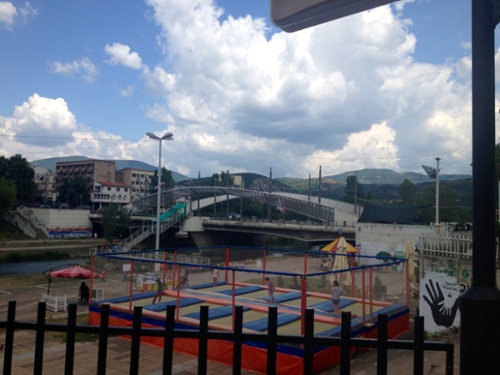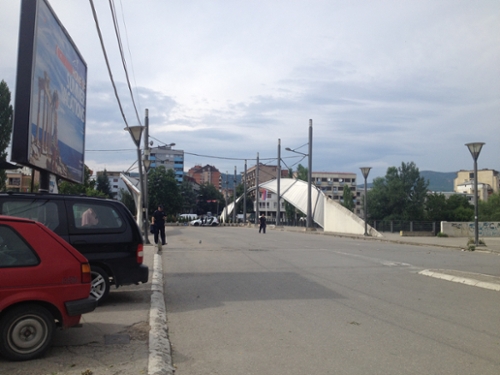A Tale of Two Bridges

[Above: Sarah Deuitch and I standing in front of Stari Most, a famous bridge in Mostar, Bosnia-Herzegovina.]
Bridge 1: Stari Most in Mostar, Bosnia-Herzegovina
Over the weekend, I met up with a fellow William & Mary law student, Sarah Deuitch. Together we traveled to three different cities in Bosnia-Herzegovina for a quick day trip. Of the three places we visited, Mostar was my favorite because of Stari Most, its beautiful UNESCO World Heritage site bridge.
War tore across Bosnia from 1992-1995. Although most Balkan countries were affected by war in the 90s', Mostar has the most physical markings of the war out of any city I've visited so far. The city has been almost entirely reconstructed, but we passed several buildings that were peppered with bullet holes. During our tour of the city, we watched a quick video that chronicled the bombing of the city that happened during the war. From that video, I learned that Stari Most was built in the 16th century by the Ottomans. Apparently, the architect was warned that if the bridge wasn't built to last forever, he would lose his life. He must have taken that to heart, because Stari Most didn't fall until November 1993 after being bombed for three consecutive days. A man was hiding out in a cave across the river from the bridge, and he filmed the bombings. Watching such a beautiful and historic structure being blown to pieces was truly heart-wrenching.
Reconstruction on the bridge commenced in 2001, and the bridge was inaugurated in 2004. Stones from the original bridge were used to help reconstruct it. I've read up a little on Stari Most online, and many think that the bridge was destroyed for symbolic reasons, to demonstrate that peaceful coexistance between the two warring parties was impossible. It naturally follows that the reconstruction of the bridge for many symbolizes reconcilliation after the conflict. It's amazing how one bridge can represent both discord and harmony at different points in time. Later in the week, I visited another bridge that has also taken on dual meanings.

[Above: View of the bridge in Mitrovica, Kosovo, that divides the predominantly Serb north from the predominantly Albanian south.]
Bridge 2: Mitrovica, Kosovo
I wrote a few ago about visiting Mitrovica in northern Kosovo, but didn't go very much into detail about the dynamics at play within this divided city.
Quick and horrendously oversimplified recent history of the region: Back in the early 90's, the country that was once Yugoslavia started to fracture becoming what is now Bosnia-Herzegovina, Croatia, Kosovo, Macedonia, Montenegro, Serbia, and Slovenia. During the breakup, Serbia (as one would imagine) had predominately Serbians. Kosovo, which was part of Serbia at the time, had mostly Albanians. Kosovo Albanians wanted liberation, Serbia didn't want that - there was bloodshed all around ending in the widespread killings of the Kosovo Albanians. NATO intervened, Kosovo declared independence from Serbia in 2008, and many countries (Serbia included) don't recognize Kosovo as a state. Currently, Kosovo is composed primarily of Kosovo Albanians (K-Albanians) with a Kosovo Serb (K-Serb) minority.
I hate to summarize such a complex situation, but that gives some background about the forces at work in Kosovo. Mitrovica is split between the northern Serb population and the southern Albanian population. As a physical reminder of the division, the Ibar River partitions the two sides. Up until a few weeks ago, the bridge was made impassable by barriers and big piles of rocks. If there's a city that tangibly shows the trauma of Kosovo's recent history, it's Mitrovica.
A few weeks ago, the prime minister ordered the barricades to be removed. For a few hours, there was normal traffic flow on the bridge. Later in the afternoon, however, Serbs in northern Mitrovica put flower boxes to block the flow of traffic as part of what is being called a "peace park." That event caused outrage in the southern Albanian community that eventually escalated into riots.
That was a few weeks ago. The controversial peace park still stands at the northern end of the bridge. This creates freedom of movement issues that are of high concern to the residents of Mitrovica. For this reason, the National Democratic Institute (NDI) organized a roundtable to discuss what civil society could do to address the freedom of movement issues. My boss was one of the panelists, so I got to take the trip up to Mitrovica the other day with D4D.

The roundtable was called "Kosovo: Facilitating Public Dialogue and Participation in the Brussel's Agreement Implementation." The Brussels Agreement was signed last year to normalize relations between Kosovo and Serbia. A representative from the Serb community discussed the ways in which this agreement was insufficient to address practical problems inside Kosovo; these problems include the fact that many in the Serb community refuse to use Kosovar car plates as they don't recognize Kosovo's statehood and many in the Serb community also feel excluded since municpal forms are often printed only in Albanian, not Serbian. The panelist critiqued the agreement as it was negotiated in Brussels with little involvment from the local community, which is one reason he argued such problems exist.
My boss represented the Albanian perspective on the panel. He discussed how the community has problems moving forward since society dwells on the idea that there is a conflict of non-tolerance in Mitrovica. This causes politicians to rehash the past instead of focusing on present issues within Mitrovica, such as the economy and water sanitation. He went on to say that the freedom of movement issues between northern and southern Mitrovica are secondary when compared with the other pressing problems in the society.
The discussion was lively, and followed with many questions from civil society representatives from around Kosovo. One concern that was expressed was the fact that the international, not local, community is driving the dialogue about the freedom of movement. Another issue is the fact that the Serb community in the north doesn't feel safe, which is one reason why the peace park was constructed. One participant discussed how civil society is necessary in facilitating the dialogue since there is still no confidence between the northern and southern residents of Mitrovica. The discussion concluded with the idea that small steps should be taken that can eventually lead to bigger changes within society.

After the roundtable, I got to walk by the bridge that has caused so much controversy. The first time I saw it at the beginning of the summer, there were big piles of rocks and concrete barricades. Now, there are flower pots on the northern sides with police patrolling since the bridge is still such a flashpoint. Aestetically speaking, the bridge looks less divisive without the rocks and barriers. Rhetorically speaking, the term "peace park" sounds much nicer than barricades. But the question remains: is the peace park facilitating peace or hindering it? Is this a necessary "small step" on the road to true reconcilliation between the northern Serb community and the southern Albanian community, or is it a big step backwards?